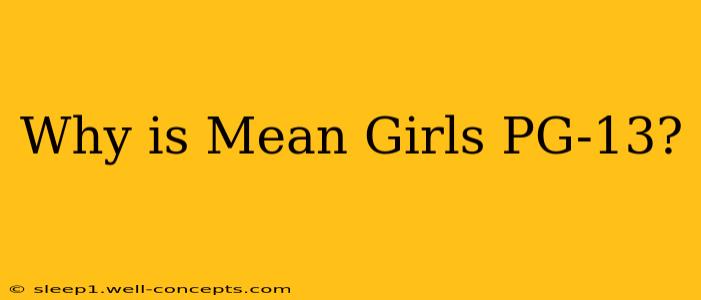"Mean Girls," a teen comedy classic, holds a special place in pop culture. But why did the Motion Picture Association of America (MPAA) give it a PG-13 rating? The answer isn't as simple as just "teenagers being teenagers." Let's dissect the reasons behind the rating, exploring the specific elements that pushed it beyond a PG rating.
The MPAA's Criteria and "Mean Girls"
The MPAA uses several factors to determine a film's rating, including:
- Thematic elements: These are the overarching messages and themes presented in the film.
- Violence: This encompasses the level and type of physical aggression, including the context and impact.
- Sexual content: This includes suggestive dialogue, nudity, and sexual situations.
- Language: The use of profanity, and its frequency and intensity.
- Drug use: The depiction of drug use, including the type of substance and its portrayal.
"Mean Girls" touches on all of these areas, albeit in a comedic and often satirical way. Let's examine each one in the context of the film.
Thematic Elements: Teenage Angst and Social Dynamics
The film tackles the complex world of high school social dynamics, including bullying, cliques, and the pressures of popularity. While not explicitly violent, the emotional manipulation and social exclusion experienced by the characters are significant thematic elements that contribute to the PG-13 rating. The themes are relatable to a teenage audience, but the intensity and consequences of these actions warranted consideration by the MPAA.
Violence: Minimal, but Present
While "Mean Girls" isn't a violent film, there are instances of implied or suggested violence. For example, the infamous "fight" scene in the cafeteria, while largely comedic, involves physical shoving and pushing. While not graphic, the intensity of the scene, and the potential for escalation, likely played a role in the rating.
Sexual Content: Suggestive Dialogue and Situations
The film contains suggestive dialogue and situations. While there is no explicit nudity or sexual activity, the conversations and interactions between characters are often laced with sexual innuendo and references. The portrayal of relationships and dating within the context of high school, while comedic, still carries an element of sexual content that warranted a PG-13 rating.
Language: Moderate Profanity
"Mean Girls" includes moderate profanity, although it's often used for comedic effect. The use of mild expletives and slang terms consistent with teenage speech patterns contributes to the overall feel of the film but again factors into the MPAA's decision.
Drug Use: Minimal and Implied
While there's no explicit depiction of drug use, there are indirect references and implications that contribute to the overall rating. The casual mention of substances, although not central to the plot, further pushed the film towards a PG-13 designation rather than a PG.
Conclusion: A PG-13 Rating Reflecting Complex Themes
Ultimately, the PG-13 rating for "Mean Girls" is a reflection of the film's complex themes, suggestive dialogue, and instances of implied violence and inappropriate language. While the film's humor is undeniably appealing to a younger audience, the MPAA rightly judged that these elements were not suitable for younger children without parental guidance. The rating accurately reflects the film's content and serves as a guideline for parents to make informed decisions about viewing.

